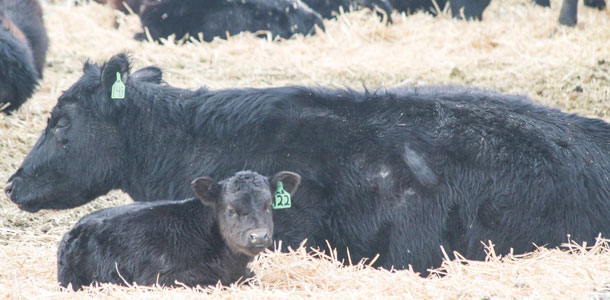Reproductive performance is significantly influenced by management practices, and therefore a good system will help to establish an economic enterprise.
Data collected in 2007 by the USDA Animal and Plant Health Inspection Services (APHIS) reported that of all beef calves born during that year, 6.4 percent were born dead or died before weaning.
In beef cattle, almost 70 percent of calf deaths occur within the first 96 hours after birth. Immediate recognition and intervention of a sick or weak calf is vital and will increase the likelihood of a positive outcome.
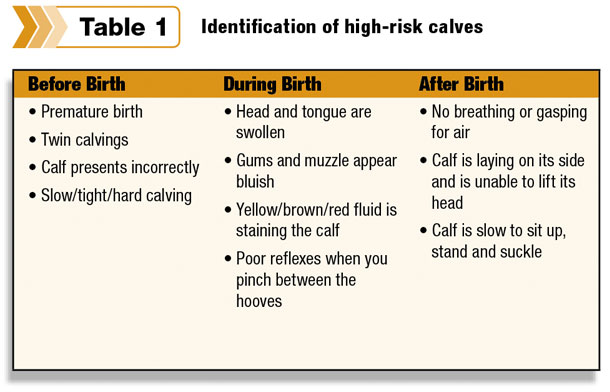
Beef calves born after birthing difficulties (dystocia) are up to six times more likely to become ill when compared to calves born without complications. Therefore, immediate intervention is important in preventing calf losses and ensuring ranch income.
Knowledge of some resuscitation strategies at the ranch level will help to achieve this goal. As in other species, the ABCs of resuscitation are airway, breathing and circulation.
Airway
- After delivery, move the calf into a sternal position; this will help to maximize air flow through the lungs.
- Clear the mouth and nose of any fluid using your hand or a suction device. A bulb syringe with tubing attached might help to suction small amounts.
Another option is to purchase a resuscitator, such as the McCulloch calf resuscitator (approximately $120), which has a plastic cylinder and a face mask to suction fluids. It is effective and easy to use.
- Do not hang the calf by its rear leg or swing it around to drain the fluid from its chest. Doing so will only bring up fluids from the stomach, not the lower airways. Additionally, this will move the gastrointestinal tract forward, pushing it against the diaphragm and therefore increasing the pressure in the chest, which makes it difficult for the lungs to expand.
However, you can place the calf in a position where its head is lower than the rest of the body to facilitate drainage from the upper airways.
Breathing
Once the calf is delivered, it should start breathing within 30 seconds. If the calf is not breathing, try the following methods:
- Pour cold water over its head; this will help to shock the calf into breathing.
- Vigorously rub its body with towels or bedding.
- Place a finger or straw in the nose to initiate the gasp reflex.
- You could try to do a mouth-to-nose or mouth-to-mouth resuscitation, but it is difficult to establish a tight enough seal to prevent air leakage, and often the air fills the stomach instead of the lungs. Keep in mind that this method increases the risk of acquiring a zoonotic disease.
Circulation
You should be able to touch the chest and feel a heartbeat. A normal heart rate for a newborn calf is 100 to 150 beats per minute. If you do not feel the heartbeat or it appears to be very slow, an external cardiac massage can be initiated; in cases where the animal is born without a heartbeat, this will be futile.
Please consult with your veterinarian about learning these techniques. Your veterinarian may also be able to administer emergency drugs to the calf in an attempt to save its life.
Other aspects to consider
Swollen head and tongue
When calves become wedged in the birth canal for a period of time, the head and tongue will be edematous and swell up. Once the calf is delivered, the circulation will improve, and over time the swelling will decrease.
Gently massaging the head might be helpful in decreasing the swelling as well. However, in some severe cases, the calf will be unable to nurse. Therefore, colostrum and nutritional support via tube feeding needs to be provided until the calf is able to suckle on its own.
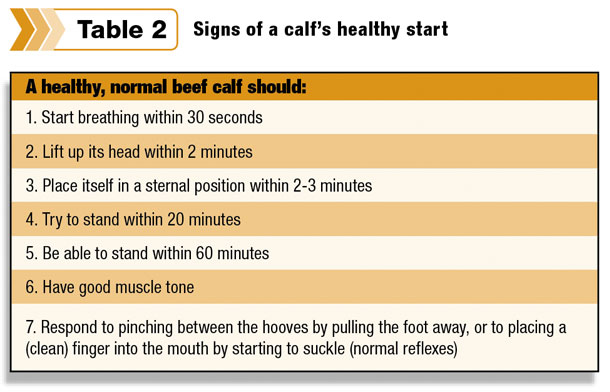
Prevention of navel ill
One of the key factors of preventing navel ill is ensuring that the calf receives early, good-quality colostrum. Additionally, it is advised to dip the navel from the tip to the abdomen in an antiseptic solution, such as 0.5 percent chlorhexidine.
Early navel disinfection subsequently reduces the risk of the calf getting sick or dying.
Temperature
Environmental conditions such as cold, wind and moisture can increase calf death. Calves experience a dramatic shift in environmental temperatures when changing from the intrauterine to extrauterine environment.
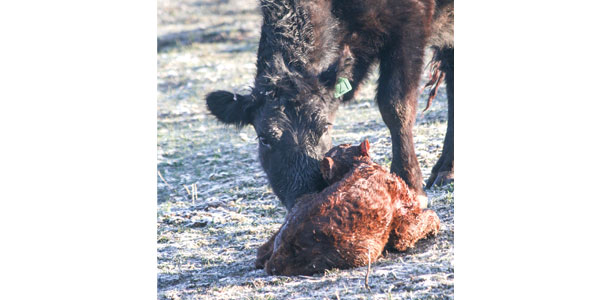
Newborn calves do not thermoregulate very well; this is even more impaired in calves born following a dystocia. Check the rectal body temperature frequently (every 10 to 15 minutes initially) and use a heat lamp, blankets, hair dryers or heating pads if needed.
You can remove the heating aid once the body temperature reaches 98 to 99ºF. However, the normal body temperature is 100 to 102ºF. Make sure that the heat lamp is not placed too close to the calf, which can lead to burning. Keep checking the calf’s temperature after removing the heating aid in case the body temperature drops again.
Colostrum
Colostrum contains antibodies against disease organisms, as well as vitamins, proteins and minerals. Calves are born without any antibodies and need to ingest colostrum within the first 24 hours after they are born.
Inadequate colostrum intake will lead to failure of passive transfer of immunoglobulins (FPT), which negatively affects the health and subsequently the survival of the calf.
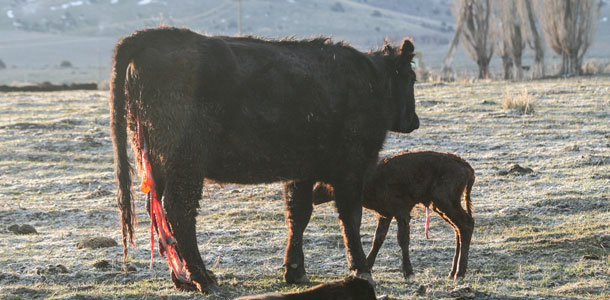
Ensuring adequate colostrum intake of high-risk calves can increase their chance of successful weaning. Dystocia calves should receive colostrum via a bottle or esophageal tube instead of relying on them standing and nursing from their dams.
Beef calves that do not get adequate colostrum intake and absorption may be nine times more likely to become ill in the pre-weaning period than calves that do receive and absorb enough colostrum.
The economic viability of a beef herd is influenced by the number of calves weaned. The care of calving cows and newborn calves is crucial to increase the profitability of your operation.
Please consult with your veterinarian to discuss the different aspects of your calf management and resuscitation efforts. ![]()
This article originally appeared in the California Cattlemen’s Association magazine, and is used with permission of the author.
Photos
Courtesy of Paul Marchant

- Anita Varga
- Gold Coast Veterinary Service
